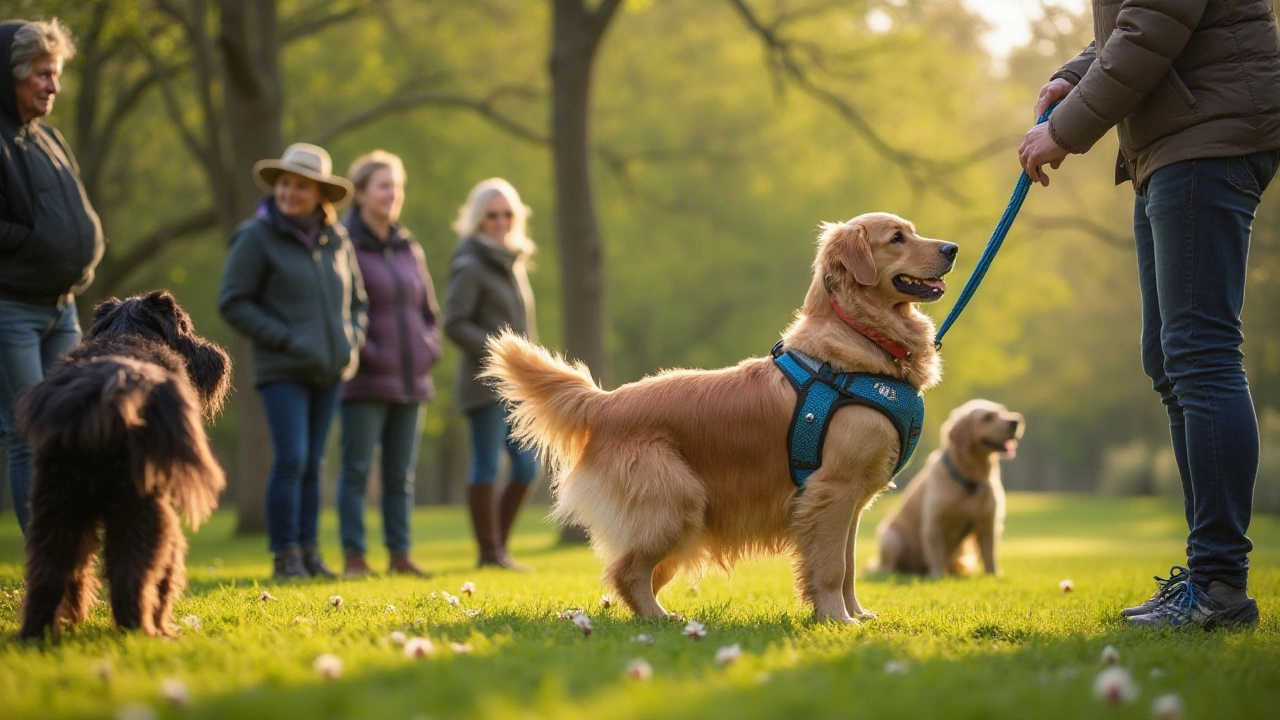When it comes to training our furry friends, the well-being and comfort of our dogs should always be at the forefront. Traditionally, prong collars have been used in the world of dog training, known for exerting pressure around a dog's neck when pulled. However, they are often criticized for causing discomfort and even injury if misused. With a growing emphasis on humane and stress-free training methods, many pet owners and trainers are seeking alternatives that are not only effective but also gentle.
There are various options to consider beyond the prong collar. Head collars gently steer dogs from the head, allowing for control without any neck strain. Martingale collars, originally designed for sighthounds, offer a secure fit without excessive pressure. Moreover, harnesses redistribute pressure across a dog's body, minimizing any risk to the neck area.
Choosing the right training tool for your dog depends largely on its size, temperament, and specific training needs. It's essential to approach training with patience, consistency, and plenty of positive reinforcement. This article will guide you through understanding why alternatives can be better, and how to implement them effectively into your training routine.
- Understanding Prong Collars
- Pros and Cons of Alternative Collars
- Choosing the Right Collar for Your Dog
- Tips for Effective Dog Training
Understanding Prong Collars
Prong collars, often referred to as pinch collars, have long sparked debate among dog trainers and pet owners alike. Their distinctive design features a series of metal links with inward-facing prongs that sit against the dog's neck. When tension is applied to the leash, these prongs create a pressure intended to mimic the corrective action that a mother dog might use with her pups. Proponents argue this mimics natural canine communication and can be effective in curbing unruly behaviors, especially in large or strong breeds.
Despite their intended purpose, many animal behaviorists and trainers caution against their use because the pressure exerted can easily transition from a gentle pinch to a painful pinch, especially in untrained hands. This can lead to physical injuries, such as punctures or bruises, and even psychological trauma, manifesting as anxiety or aggression in dogs. These potential downsides have led to a growing push within the pet care community for more humane training methods. As the understanding of canine psychology evolves, so does the awareness of how stress-free environments can greatly enhance the training experience.
In assessing whether a prong collar is appropriate for your pet, it's essential to consider the dog's breed, size, and specific behavior issues. Prong collars are not one-size-fits-all gadgets, and their success can vary dramatically depending on the scenario. For instance, a prong collar might be less effective on smaller, more delicate breeds due to the potential for harm. For larger, more resilient breeds, the risk might seem negligible at first, but it's worth exploring alternatives that achieve the desired training outcomes without risking harm. Various veterinary professionals and dog behavior experts now advocate for collars and harnesses that prioritize safety and well-being. Innovations in pet products continue to offer solutions that blend effectiveness with comfort.
"A dog collar should not be just a tool of convenience or control, but a bridge to understanding and compassion," notes Dr. Emily Weiss of the ASPCA.
Understanding the historical context of prong collars also sheds light on their contested place in contemporary dog training practices. Originally designed in Germany, these collars were primarily crafted with functionality in mind, catering to working dogs that required immediate obedience in high-stakes environments. Yet, as pet companionship has evolved, the utility of such collars is increasingly viewed through the lens of ethical training methods that foster trust and cooperation rather than impose dominance.
Whether a prong collar remains a part of one's training toolkit should rest on thorough research and a genuine concern for the pet's health and contentment. As we advance in understanding canine needs and behaviors, moving towards methods that offer mutual respect and empathy only serves to strengthen the bond between people and their cherished animals. Modern alternatives, highlighted right throughout this discussion, have emerged as strong contenders for effective dog training without compromising on care or concern for our four-legged friends.

Pros and Cons of Alternative Collars
Choosing the right collar for your dog can be quite a challenge, given the vast array of options available on the market. Among these alternatives, harnesses, head collars, and Martingale collars stand out due to their gentle yet effective design. Let's dive into the details of each, weighing their pros and cons. Harnesses have grown tremendously in popularity due to their comfort and practicality. A major advantage is the even distribution of pressure, which prevents choking or damage to your dog's neck. For dogs that tend to pull, using a harness can considerably reduce strain on their throat, making it a more humane option compared to prong collars. While effective, it's important to find a harness that fits well, as an incorrect fit could lead to escape or discomfort. A well-fitted harness can often become a dog's best companion during walks, transforming the experience for both the owner and the pet.
Head collars, often resembling a horse's halter, offer gentle control by guiding a dog's head. This translates into steering their body, allowing handlers to redirect focus and manage pulling with ease. They are particularly beneficial for large or strong dogs who may otherwise be difficult to manage safely. However, they require acclimatization, as some dogs may find the sensation around their muzzle unusual at first. With patience and gradual introduction, most dogs adapt well, which supports effective control without resorting to harsh methods. A contentious yet relevant point is that head collars are often misunderstood as muzzles, which can lead to misconceptions about a dog's temperament.
Dr. Sophia Yin, a renowned veterinarian, once stated, "Gentle, consistent leadership is key to any successful dog training regime. Always prioritize methods that balance control with compassion."
Finally, we have the Martingale collars, which were first designed for breeds with slender heads, like greyhounds. These collars tighten slightly when pulled, preventing escape without causing the discomfort associated with prongs or choke chains. Their design makes them an excellent choice for dogs prone to slipping out of traditional collars. Pet parents should ensure the fit is right; it should be snug but not restrictive, allowing two fingers to slip between the collar and the dog's neck when at rest. The elegance and simplicity often make Martingale collars a visually appealing and functional choice.
When deciding on the right collar, consider your dog's size, behavior, and specific needs. Each collar type offers unique strengths that can enhance your training efforts, promote positive behavior, and ensure the safety and comfort of your beloved pet. With this knowledge, you can make informed decisions, rooted in the desire to foster a trusting relationship with your canine companion.
| Collar Type | Pros | Cons |
|---|---|---|
| Harness | Distributes pressure, controls pulling, no neck strain | Poor fit can cause discomfort or escape |
| Head Collar | Strong control, reduces pulling, humane approach | Requires adaptation, may be misunderstood |
| Martingale | Prevents escape, suitable for slim-headed breeds | Must be properly fitted to avoid discomfort |

Choosing the Right Collar for Your Dog
Choosing the perfect collar for your dog is often an intricate process, not unlike picking out the right pair of glasses for yourself. It requires a keen understanding of your dog's unique personality, physical traits, and training needs. While some pet owners might lean towards flashy, fashionable collars, the prime factor to always consider should be comfort and purpose. A collar isn't just a neck accessory; it's a tool that plays a crucial role in effective training and daily control.
When considering alternatives to prong collars, the humane collars come highly recommended. Head collars, for instance, are excellent for dogs that have a tendency to pull aggressively. They work on the principle of steering a dog’s head where you want them to go. This not only provides better control but also aligns with the dog's natural movement, minimizing resistance and discomfort. There’s often a learning curve with head collars, but eventually, they prove to be beneficial and safe.
Then there's the revered martingale collar, which has gained popularity among dog owners who want a reliable yet gentle option. Originally crafted for greyhounds and other dogs with necks wider than their heads, these collars gently tighten when pulled, preventing escapes without the harsh grip of a traditional choke chain. The added security without sacrificing any comfort makes martingales ideal for many dog breeds. According to Wendy Wilson, an experienced dog trainer, "Martingales are life-savers for dogs with slender heads. It’s about time more people recognize their efficacy beyond the world of sighthounds."
For those dealing with boisterous dogs, a well-fitted harness can be the answer to your prayers. Unlike collars which focus pressure on the neck, harnesses disperse it across a broader area of the body, reducing strain and making them perfect for larger breeds or pups with delicate throats. Choosing between a back-clip and a front-clip harness depends on your dog's behavior. Front-clip designs discourage pulling, making them excellent for day-to-day training.
When you're stumped on decisions and need some expert guidance, don't be afraid to pop by your local pet shop. Experienced staff can offer insights based on what works for different size and breed of dogs. They might let you test out various collar types to see how your dog responds. Remember that the size of the collar is just as important as the type. A snug fit, where two fingers can slide comfortably under, is usually perfect, preventing both discomfort and potential escape.
To help visualize the variety of collar choices, here's a simple table comparing common attributes of each option. It can serve as a guide for your decision-making process:
| Type | Attributes | Best For |
|---|---|---|
| Head Collars | Gentle control, reduces pulling | Strong dogs, training purposes |
| Martingale Collars | Prevents escapes, gentle tightening | Sighthounds, slender-headed dogs |
| Harnesses | Pressure distribution, less strain | Boisterous dogs, sensitive throats |
Ultimately, the choice of collar makes a significant difference in both training success and your dog's comfort. By prioritizing your pet’s specific needs and lifestyle, you ensure that both safety and happiness are uppermost. It's not just about finding an alternative to the prong collars, but establishing a connection based on trust and ease. Always aim for what encourages positive interactions and comfort for your furry friend.

Tips for Effective Dog Training
Effective dog training often starts with understanding your dog's unique personality and needs. Dogs are as individual as the people who train them, and recognizing this can greatly influence the success of training sessions. Start by spending quality time with your dog, observing their behaviors, likes, and dislikes. This foundation not only strengthens the bond between you and your pet but provides critical insights into choosing the right training methods and tools, such as humane collars or harnesses. It's important to note that consistency is key. Ensuring that every member of your household follows the same set of training commands and rules will prevent confusion and help your dog learn quicker. Remember, patience is crucial; not every dog will respond at the same pace.
Positive reinforcement is one of the most effective strategies in dog training. Rewarding your dog with treats, praise, or playtime immediately after they perform a desired action encourages them to repeat it. This method is supported by scientific research, which shows that positive experiences are more likely to lead to desired behavior changes. According to Dr. Sophia Yin, a renowned veterinarian and animal behaviorist, "Positive reinforcement training is not only the most scientifically valid method but also the most efficient and humane." Utilizing this approach can transform your training sessions into enjoyable experiences for both you and your canine companion. Consistent rewards for desired behaviors foster an environment where your dog feels confident and eager to learn.
Maintaining Structure and Routine
Establishing a routine helps dogs understand what is expected of them and reduces anxiety by providing a predictable schedule. Dogs thrive on routine and structure, through which they understand when it's time to eat, play, and train. Implement structured training sessions at regular intervals, ensuring they are short enough to keep your dog's attention but frequent enough to ensure retention. Repeating commands like "sit" or "stay" during these times reinforces their learning. A mix of training environments—sometimes at home, other times in the park—can help your dog generalize their behaviors across different contexts.
The Role of Socialization
Early socialization is a vital component of effective dog training. Exposing your pet to different environments, people, and other animals helps reduce anxiety and fear-related behaviors later on. Introduce your dog to a variety of experiences in a controlled manner, ensuring each exposure is positive. This can involve taking them on short walks to quieter locations initially, progressing to busier areas as your dog's confidence grows. This builds a well-rounded, adaptable pet that is comfortable in various situations. A well-socialized dog is generally easier to train and adapt to new experiences, reducing stress on both the owner and the pet.
In addition to these strategies, utilizing the right training equipment, such as the best dog collars, can enhance your training efforts. With patience, consistency, and the right approach, training can transform from a chore into a rewarding bonding experience, enriching the lives of both you and your dog.







